Joseph was Imhotep of Egypt
He built
the first pyramid in Egypt at Saqqara
and stored grain in underground silos there
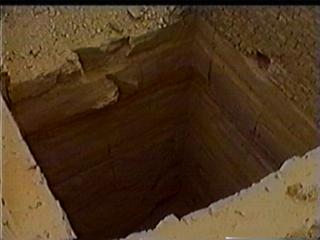
Above: One of the underground grain silos used to save Egypt from
famine
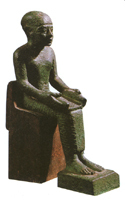
Statue of Imhotep holding a papyrus scroll in his lap.
Read in-depth the research on Joseph in
Egypt
and evidence showing the grain storage next to the first pyramid
National Geographic, January 1995, describes a man called
Imhotep who saved his country from a famine. "Perhaps most confident was
Imhotep, the architect who probably conceived of building Djoser's [pharaoh]
tomb completely from stone. Known as a sculptor, a priest, and a healer, Imhotep
is considered the preeminent genius of the Old Kingdom. He assembled one
workforce to quarry limestone to ship the crude blocks by boat to Saqqara, and
yet another to haul the stone to the site, where master carvers shaped each
block and put it in place.
"On a granite boulder above the Nile's First Cataract, the
formidable rapids at Aswan, a sculptor who lived much later [thus the facts are
not totally accurate] chiseled out in hieroglyphs the story of how Imhotep had
even saved his country from famine.
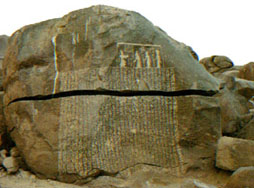
In 1890 Charles Wilbour discovered this boulder
on the island of Sahal at the Nile, telling a story of Imhotep
The annual Nile flood, which inundated surrounding fields every
autumn before farmers sowed their seed, failed seven years in a row.
Djoser asked Imhotep where the source of the river lay. The pharaoh
intended to travel there to interrogate the river gods and beg them to show
mercy on his people.
"But Imhotep replied that sacred [God] books had given him the
answer.... The floods returned, and the famine was over....
"In about 1200 B.C., fully 1400 years after his death, Imhotep,
the genius architect of Djoser's reign, was deified by the Egyptians, who built
cult temples to honor him."
Joseph in Ancient Egyptian History
By Mary Nell Wyatt
Based on Ron Wyatt's research
It's rather amazing how historians and archaeologists have
managed to explain away evidence which validates the Biblical account.
Myths and legends derived from actual events of biblical times are found
all over the world, such as the multitude of Flood stories, but to the
unbeliever these only prove that the Bible was influenced by these myths.
The fact is that these myths are satanic corruptions of
the truth, designed by Satan to convince man that in his own cleverness,
he is smarter than God. And ultimately this kind of thinking leads a
person to deny entirely the existence of God and the truth of the Bible.
Yet, no one seems to think it strange that every known
civilization has had some type of religious system. If there is no God,
where did this idea of religion and gods come from? It came from the
original truths known by the original post-flood family of Noah. The facts
which have been found validate the biblical account, not the myths and
legends. But there will always be those who simply will not see.
Some of these great evidences relate to the story of
Joseph in ancient Egypt. Inscriptions on a monument to Horemheb, a pharaoh
several years after the Exodus, provide evidence of the story of the
pharaoh in Joseph's day extending an invitation to Jacob's family to come
live in Egypt.
It tells of a community of shepherds from the north asking
Egypt to allow them to pasture their cattle "as was the custom of the
father of their fathers from the beginning." There is also a picture in
the tomb of Tehuti-hetep in Bersheh which has a picture of a herd of
Syrian cattle entering Egypt with the inscription:
-
"Once you trod the Syrian sands. Now, here in Egypt, you
shall feed in green pastures." (Light from the Ancient Past, by Jack
Finegan.)
The evidences which parallel the story of Joseph are the
focus of this newsletter. But first, we must set the stage.
According to our chronology, taken from the biblical
record, the flood occurred about 2348 B.C. Abraham left Haran in about
1921 B.C., about 427 years later. Soon after this (we don't know exactly
how soon) he and Sarah went to Egypt because of a famine in Canaan.
The biblical account is extremely short on the subject of
Abraham's visit to Egypt (Gen. 12:10-20), but we do learn that Abraham
misled the pharaoh about who Sarah was, as he told pharaoh she was his
sister. This was partially true since she was his half-sister, but she was
also his wife.
The pharaoh took her to his palace since she was so
beautiful. (Gen. 12:12-15). The king paid Abraham well for Sarah (verse
16) but God intervened, causing some types of plagues to fall upon the
pharaoh. (verse 17). When the pharaoh figured out the cause for these
inflictions, he called Abraham to account, asking him why he lied to him
about Sarah. (verse 18, 19). He then ordered his men to escort Abraham and
his entourage out of Egypt. (verse 20)
Egypt at this time was already a rich nation, for it was
at this time that Abraham became rich in cattle, gold and silver, given to
him as payment for Sarah. (Gen. 13:1,2). And there is good evidence that
it was at this time that the regulation prohibiting the Egyptians from
eating, drinking or fraternizing with foreign shepherds was instituted.
(Gen. 46:34).
Josephus relates that Abraham was responsible for bringing
the knowledge during the early part of the First Dynasty, about 1915 BC.
It would be about 200 years later when Joseph would be
elevated to his high position in Egypt, second only to the pharaoh. During
this same time of the 3rd Dynasty, there appears on the scene a most
incredible individual in the ancient records- a man called Imhotep.
For many years, Egyptologists had doubted that Imhotep had
been a real person -- they found it rather difficult to believe the
various accomplishments credited to him in the accounts written over a
thousand years after he was supposed to have lived. At times Imhotep has
been termed the Leonardo da Vinci of ancient Egypt, but in fact he was
more than that. Da Vinci gained the reputation of a genius -- Imhotep was
eventually elevated to the status of a god.
In Egypt's long list of gods, very few were ever actually
living among them, but Imhotep did. Manetho wrote that "during his [Djoser
of the 3rd Dynasty] reign lived Imouthes [i.e., Imhotep], who, because of
his medical skill has the reputation of Asclepius [the Greek god of
medicine] among the Egyptians and who was the inventor of the art of
building with hewn stone." It was this statement that caused the
specialists to doubt the existence of a real man named Imhotep. But in
1926, the question was settled once and for all -- Imhotep was a real man.
When excavations were carried out at the Step Pyramid at
Sakkara, fragments of a statue of
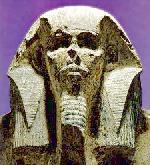
pharaoh Djoser were found. The base was
inscribed with the names of Djoser and of ...
-
"Imhotep, Chancellor of the King of Lower Egypt, Chief
under the King, Administrator of the Great Palace, Hereditary Lord, High
Priest of Heliopolis, Imhotep the Builder, the Sculptor, the Maker of
Stone Vases..."

Inscription showing the name and titulary of Imhotep
 in the 3rd row to the left, and the
Horus-name of Djoser. This inscription was found on the base of a
sculpture of Djoser, thus indicating Imhotep was a real man, as opposed to a
god. in the 3rd row to the left, and the
Horus-name of Djoser. This inscription was found on the base of a
sculpture of Djoser, thus indicating Imhotep was a real man, as opposed to a
god.
Does this fit what we know of Joseph? The Bible is quite
clear on his high rank under the pharaoh:
-
"Thou shalt be over my house, and according unto thy
word shall all my people be ruled: only in the throne will I be greater
than thou. And he made him to ride in the second chariot which he had;
and they cried before him, Bow the knee: and he made him ruler over all
the land of Egypt. And Pharaoh said unto Joseph, I am Pharaoh, and
without thee shall no man lift up his hand or foot in all the land of
Egypt." Genesis 41:40-44
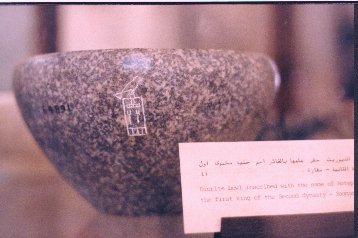 Left - Stone vase at Saqqara with
Imhoteps inscription. See
www.sunship.com/egypt/articles/hrdfact3.html for stone vases Joseph
made at Saqqara. There were thousands found there which were created by
extremely talented people using sophisticated lathes. Left - Stone vase at Saqqara with
Imhoteps inscription. See
www.sunship.com/egypt/articles/hrdfact3.html for stone vases Joseph
made at Saqqara. There were thousands found there which were created by
extremely talented people using sophisticated lathes.
In fact, it sounds as if Joseph was the first person ever
given such honor by a pharaoh, which is confirmed by evidence in Egypt. If
this man, Imhotep was Joseph, surely there must be some evidence tying him
with the Biblical account.
Inscription of the 7
Year Famine
Joseph's main position was that of a prime minister
and Imhotep appears to be the first who could boast of such a broad
range of authority in ancient Egypt. There are records of many, many
viziers throughout Egyptian history- but the first evidence which
connects Imhotep with Joseph is an amazing inscription found carved
on a large rock on the island of Sihiel just below the First
Cataract of the Nile. (photo at top of page)
This inscription claims to be a copy of a document
written by Djoser in the 18th year of his reign,- this copy being
written over 1,000 years after the events it claims to be relating.
It goes on to tell of a seven year famine and seven
years of plenty. Let's look at a few passages from this inscription
and compare them with the biblical account, keeping in mind that
this was written a millennium after the events it claims to be
describing:
-
2. In the inscription, the pharaoh is troubled
about a famine and asks Imhotep who the god of the Nile is, so he
can approach him about the drought: "... I asked him who was the
Chamberlain,...Imhotep, the son of Ptah... `What is the birthplace
of the Nile? Who is the god there? Who is the god?'" Imhotep
answers: "I need the guidance of Him who presides over the fowling
net,..." The Bible: "And Joseph answered Pharaoh, saying, It is
not in me: God shall give Pharaoh an answer of peace." Genesis
41:16
In the Egyptian text above, Imhotep is termed "the
son of Ptah", who was the Egyptian god known as the "creator" of
everything else, including the other gods.
-
3. In the inscription, Imhotep answers the pharaoh
about the god of the Nile and tells him where he lives. In the
Bible, Joseph interprets the pharaohs dream. But, the next part of
the inscription tells that when the king slept, the Nile god Khnum,
revealed himself to him in a dream and promised the Nile would
pour forth her waters and the land would yield abundantly for
seven years, after a seven year drought. This passage reflects the
fact of a dream by the pharaoh of seven years of plenty and seven
years of famine, although reversed.
-
4. The inscription then goes on to record Djoser's
promise to the Nile god, Khnum, in which the people were to be
taxed 1/10 of everything, except for the priests of the "house of
the god," who would be exempted. The Bible: "And Joseph made it a
law over the land of Egypt unto this day, that Pharaoh should have
the fifth part, except the land of the priests only, which became
not Pharaoh's." Genesis 47:26
So here we have an inscription which tells a story
of pharaoh Djoser asking his vizier, Imhotep, to help him with the
problem of a great seven year famine. Imhotep tells him he must
consult the god because the answer is not in him. Then, the pharaoh
dreams a dream which foretells the event. Next follow seven years of
plenty, which is reverse from the Biblical account. The pharaoh
levies a tax of 10% on all of the population except for the
priesthood. The Biblical account tells of a 1/5, or 20% tax, with
the priesthood exempt. All of the components of the Biblical account
are present in this inscription, except that the story has been "Egyptianized"
to fit their religious beliefs.
It is believed that this inscription was written
during the 2nd century BC, by the priests of Khnum for the purpose
of justifying their claim of some land privileges. Part of the
inscription states that the pharaoh dedicated some of the land and
taxation to the god. But, this isn't the only inscription with this
story - there is a similar inscription on the Isle of Philae, only
this one has the priests of Isis stating that Djoser made the same
gift to their god for the same purpose. Just as the story of the
flood is found in almost every ancient culture but is twisted to fit
their own purposes and gods, here we find the story of Joseph, only
it is twisted to fit the needs of the priests of the various gods in
substantiating their claims to certain land.
"Imhotep, the Voice of the God, Im (I AM)"
The name, Imhotep, in ancient Egyptian is translated
to mean "the voice (or mouth) of Im"; however, there is no record of
a god in Egypt called "Im". But, we all know the God, "I AM":
-
"And God said unto Moses, I AM THAT I AM: and he
said, Thus shalt thou say unto the children of Israel, I AM hath
sent me unto you." Exodus3:14
-
"Jesus said unto them, Verily, verily, I say unto
you, Before Abraham was, I am." John 8:58
God told Moses to tell the pharaoh that "I AM" had
sent him because "I AM" was the name by which the Egyptians had
known Joseph's God. Could "Im" have been "I AM"?
The Bible states the name that was given to Joseph
by the pharaoh, Zaphenath-paneah. It has been translated by some to
mean, "the God lives; the God speaks". Since we do not fully
understand the meaning of the Egyptian word "hotep," it is quite
possible that the translation of Imhotep ("The voice of I AM) is
identical to the Biblical name of Joseph ("the God lives; the God
speaks).
Imhotep - the Physician
Imhotep is the earliest physician whose historical
records survive, and although Joseph isn't mentioned as being a
physician, the Bible gives one very important clue to this:
Here, the physicians are specifically stated to be
under Joseph. But later, when Imhotep became established as the "god
of healing," it is the manner in which he healed that ties him
directly to Joseph.
Ancient Greek writings mention a great sanctuary at
Memphis where people came from everywhere to seek cures from Imhotep.
They would pray to him, make offerings and then spend the night in
this sanctuary, which was a sort of Lourdes of ancient Egypt. While
sleeping, the god Imhotep, was said to come to people in their
dreams and cure them. Is there a connection between Joseph and
dreams?
-
"Come now therefore, and let us slay him, and cast
him into some pit, and we will say, Some evil beast hath devoured
him: and we shall see what will become of his dreams." Genesis
37:20
The Wisdom of Imhotep
The Biblical account also speaks of Joseph's wisdom:
Again, the evidence points to Imhotep. Imhotep was also
revered for his wisdom. In several inscriptions from much later times,
reference is made to the "words of Imhotep." For example, in "Song from
the Tomb of King Intef," we read: "I have heard the words of Imhotep and
Hardedef...", and it goes on to explain that their "sayings" were recited
in his day.
To date nothing has been found of Imhotep's works, however
there are several works of "wise sayings" attributed to one Ptahotep, who
is only known as a vizier of a king from the 5th dynasty. However, there
are five known Ptahoteps, all viziers to pharaohs of the 5th dynasty, all
priests of Heliopolis, or On. Evidence seems to indicate that after
Imhotep, the trend among viziers became patterned after him, with these
later viziers taking credit for Imhotep's actual deeds and his writings --
a practice which the Egyptians and others, were notorious for.
Now, let's do some assuming for a moment -- let's assume
that Joseph wrote a collection of wise sayings, inspired by God. Because
of his great favor with the king, these came to be revered by the scribes
and people. His fame as a sage spread throughout Egypt and became the
standard of wisdom. We know that his wisdom came from the true God of
Abraham. Would it not be expected that Joseph would pass on his wisdom
from God to those around him? In fact, the Bible says that he did:
-
"He sent a man before them, even Joseph, who was sold
for a servant... The king sent and loosed him; even the ruler of the
people, and let him go free. He made him lord of his house, and ruler of
all his substance to... teach his senators wisdom." Psalms 105:17-21
After Joseph's death, others copied his wise sayings and
took credit for them, perhaps adding a bit of their own and changing
things to suit them. As these sayings were passed down through several
generations, instead of being attributed to Imhotep, they were attributed
to Ptahotep, "the voice of" the Egyptian creator, Ptah. Thousands of years
later, several papyruses are found which purport to be copies of "The
Instruction of Ptahotep." Could this scenario have happened?
There are two particular statements in Ptahotep's writings
which indicate that this is exactly what happened. At the end of these
manuscripts, the writer states that he is near death, having lived 110
years and that he received honors from the king exceeding those of the
ancestors -- in other words, he received the most honors ever given a man
by a pharaoh. Also, we know that Joseph died at the age of 110 years.
Well, it gets even more familiar as we examine the text of these
manuscripts.
They begin as Solomon's Proverbs begin, as instructions to
his son, with the admonition they are "profitable to him who will hear"
but "woe to him who would neglect them". Keep in mind that the Originator
of Joseph's wisdom was also the Originator of Solomon's wisdom, and the
parallels between the two are undeniable. We are told in the Bible that
Solomon knew many, many proverbs:
This statement indicates that the concept of a "proverb"
was known to the ancient peoples. We aren't told if Solomon was the author
of all of these proverbs or whether they were passed down to him from his
ancestors. There are examples of proverbs in many ancient civilizations,
but the only ones which Solomon recorded by inspiration and today appear
in the Bible are very similar to the ancient Egyptian "wisdom literature"
which can be traced back to Imhotep.
This doesn't mean that Solomon copied from the ancient
Egyptians- it means that the God of His Fathers gave the same wisdom to
his ancestors, who included Joseph. We'll compare a few passages of
Ptahotep's writings to the Bible:
-
3) "If you probe the character of a friend, don't
enquire, but approach him, deal with him alone." (Ptahotep) "Debate thy
cause with thy neighbor himself; and discover not a secret to another."
Proverbs 25:9
-
4) "If you are a man of trust, sent by one great man to
another, adhere to the nature of him who sent you, give his message as
he said it." (Ptahotep) "As the cold of snow in the time of harvest, so
is a faithful messenger to them that send him: for he refresheth the
soul of his masters." Proberbs 25:13
We also find parallels in other books, such as Psalms and
Ecclesiastes:
-
6) "If every word is carried on, they will not perish in
the land." (Ptahotep) "For he established a testimony in Jacob, and
appointed a law in Israel, which he commanded our fathers, that they
should make them known to their children: That the generation to come
might know them, even the children which should be born; who should
arise and declare them to their children." Psalms 78:5-6
-
7) "Guard against the vice of greed: a grievous sickness
without cure. There is no treatment for it." (Ptahotep) "A man to whom
God hath given riches, wealth, and honour, so that he wanteth nothing
for his soul of all that he desireth, yet God giveth him not power to
eat thereof, but a stranger eateth it: this is vanity, and it is an evil
disease." Ecclesiastes 6:2
-
8) "If you are a man of worth who sits in his master's
council, concentrate on excellence, your silence is better than
chatter... gain respect through knowledge..." (Ptahotep)"The words of
wise men are heard in quiet more than the cry of him that ruleth among
fools." Ecclesiastes 9:17
-
10) "If you are one among guests at the table of one
greater than you, take what he gives as it is set before you." (Ptahotep)
"When thou sittest to eat with a ruler, consider diligently what is
before thee." Proverbs 23:1
God used Joseph to establish in Egypt a safe haven for the
growth and development of the "seed of Abraham" until they were ready to
be delivered into the land God had promised them. And while in Egypt,
surrounded by paganism, God would not leave His people nor the Egyptians
without access to His Truth.
The Bible records the fact that Joseph even taught the
pharaoh's "senators." While this wisdom was revered by the Egyptians and
carried down through the ages by their sages who copied some of his
writings (claiming it as their own), some of these same "wisdom sayings"
were recorded by some of Joseph's descendants over 700 years later, and
ultimately were preserved for us in the Book of Proverbs, Ecclesiastes and
Psalms. But Joseph's wisdom didn't originate with him -- it was divinely
inspired, as was Solomon's wisdom, David's wisdom and the wisdom of all of
God's people.
Plywood in Ancient Egypt
In the earlier mentioned book, "Saqqara", on the bottom of page 99 is a
statement about the knowledge and use of laminated "plywood" in very early
Egypt:
"...within the remains of a coffin whose sides were made of six thin
superimposed layers of wood with the grain alternating as in modern ply
wood."
As you know the deck boards of Noah's ark were made of laminated (ply)
wood, based on the fact the we have an actual specimen. The use of the
same material by the early Egyptians proves that this knowledge was
available in the early years of ancient Egypt, passed along though Noah's
offspring as they began to settle throughout the world. It would probably
stagger the imagination if we knew how much technology was lost by man
after the flood.
Imhotep Appointed Later in Djoser's Reign
There are several other items concerning Imhotep
which continue to fit the biblical account. We know that the pharaoh
of Joseph had been king for an unknown period of time when Joseph
was finally brought to him to interpret his dream. And the evidence
shows that Imhotep was not Djoser's vizier earlier in his reign --
in fact, no mention is made at all of Imhotep on Djoser's earlier
monuments.
Imhotep was not the architect of Djoser's tomb built
at Beit Khallaf, which was probably undertaken soon after he became
king. In this earlier tomb, which is similar to the preceding
dynasties as Sakkara, there are clay sealings of jars which record
Djoser's name, his mother's name, and the names of numerous other
officials from his reign -- but not Imhotep's, which indicates that
he hadn't been appointed to his position yet.
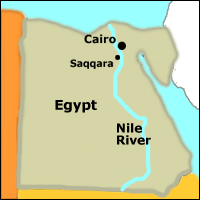
Location of Saqqara in Egypt
The standard practice was for the pharaoh always to
appoint men to office as soon as he took the throne, with family
members being the highest ranked.
All available information about Imhotep continues to
point to his identification with Joseph. For example, in some
inscriptions, his titles indicate that he was not a member of the
royal family, but a "self-made man." This was unique because the son
of the pharaoh was usually the vizier.
Imhotep was also the "priest of Heliopolis," the
biblical On. Now in the story of Joseph, we learn that his
father-in-law was the "priest of On" at the time of Joseph's
marriage:
Since Asenath was old enough to marry Joseph at this
time, it follows that her father was probably at least in his
forties. In ancient Egypt, the people didn't live too much longer
than about 50. At his death or disability, it follows that his
son-in-law would be assigned his position, especially if that
son-in-law were so highly regarded by the pharaoh as Joseph was.
If Joseph became the "Priest of On," was he being
unfaithful to the true God? Absolutely not -- the pharaoh had
recognized the power of the God of Joseph, and even though the
Egyptians remained idolaters, Joseph made them aware of his God and
was unswerving in his loyalty to Him. The "Priest of On" was not
termed the priest of a particular god -- but the title instead seems
to indicate a position of high honor and political importance.
Imhotep, the Architect of the
first Pyramid, often called the Step Pyramid

It was Imhotep who is credited with having designed
the first pyramid (above) and began building with hewn stone instead of all
mud brick. If we look at ancient Egyptian history, we can see
evidence which shows that it was during the time of Djoser that
Egypt became a truly great nation -- since it had gathered the
wealth of all the surrounding nations by selling them grain during
the famine.
And during the seven years of plenty, the people,
under Joseph's wise guidance, began to organize a great
administrative center which would handle the selling of the grain to
all the surrounding nations.

The complex at Saqqara Egypt was built during the reign of the
pharaoh Djoser. Imhotep - Joseph built this complex.
A large complex was built which contained the future
burial site of the pharaoh but also included a walled-in center
which contained huge grain bins. There was only one entrance into
this center and there was an outside entrance into the system of
storage bins. The Step Pyramid complex at Sakkara is the complex
which we will now discuss.
Grain Storage Bins
Surrounding the Step Pyramid, the first ever built,
is a very beautiful and elaborate wall containing 13 false entrances
and one real. At the main entrance on the east wall at the
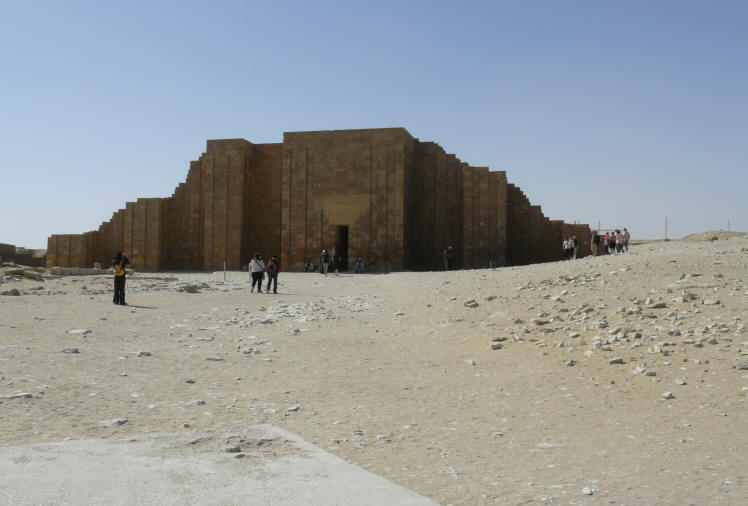
Above: Grand entrance into complex with
pyramid to our right, out of photo
southern end, one enters a long hall of 40 columns -- 20 on each
side. Each column is connected to the main wall by a perpendicular wall,
forming small cubicles between
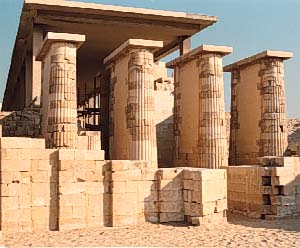

each column.
As you exit this colonnade and walk straight ahead, you come to a
series of very large pits which extend deep into the earth. See
below:


 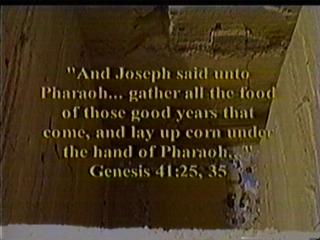

Above are some of the grain storage bins.
These are extremely large in size -- much larger
than any burial chambers; they are all centrally accessible by a
connecting tunnel, extend to well above ground level, and one has a
staircase extending down to the bottom (see below). For this reason, we know
that they were not built as tombs -- if they were, they would have
been constructed underground and they certainly would not have been
so incredibly large.

Above: Steps leading down to one central exit point for the
underground grain silos
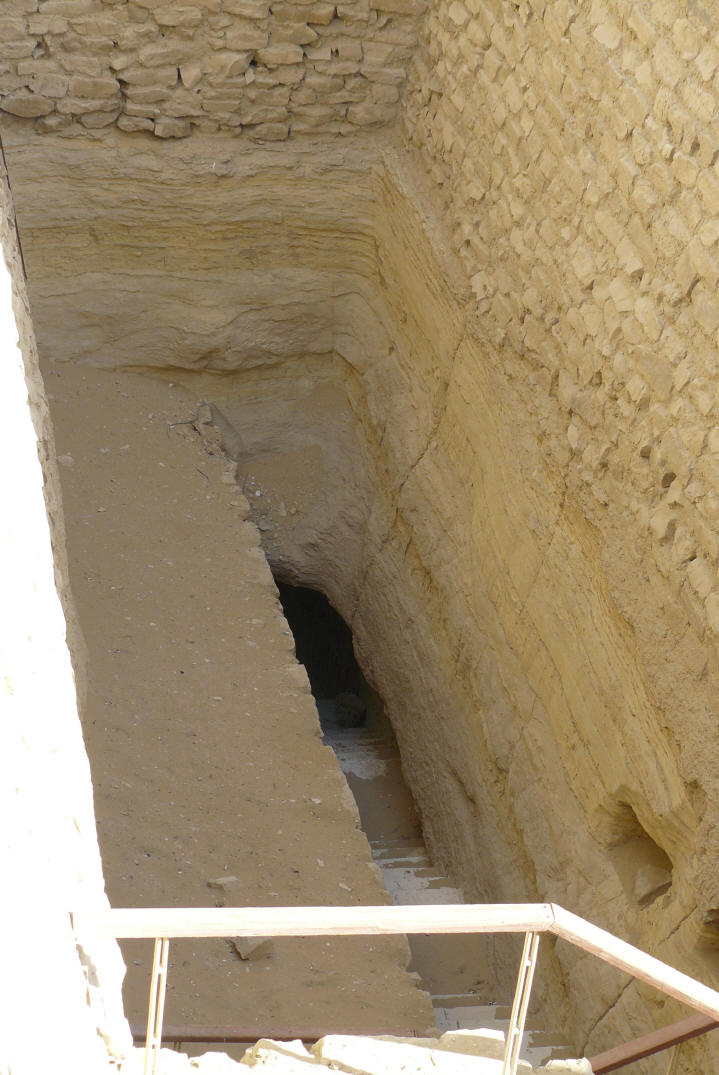
Above is the staircase that leads to a central exit
point for all the grain storage bins.
These massive structures extend to well above ground
level, which indicates that they were not hidden, as were tombs.
Because the ancient Egyptians buried their dead with so much
valuable material and provisions for their "afterlife," plundering
of tombs was always their biggest fear. Therefore, we know that
these massive pits had another purpose. Also, in all the other
ancient cities, whenever large bins such as these were uncovered,
they were recognized as storage bins, but in Egypt, the scholars
tend to term everything they find a "tomb."
However, in the pharaoh's burial complex under the
pyramid, we find matching bins for the king and his family's
afterlife- and in these bins were found grain and other food stuffs.
In the Biblical account, we learn that Joseph
appointed men throughout the land of Egypt to oversee the gathering
and storing of the grain in all the cities:
-
"Let Pharaoh do this, and let him appoint officers
over the land, and take up the fifth part of the land of Egypt in
the seven plenteous years. 35 And let them gather all the food of
those good years that come, and lay up corn under the hand of
Pharaoh, and let them keep food in the cities."
Joseph had given this plan to the pharaoh prior to
his appointment as vizier or prime minister, and since it would be
impossible for him to oversee the gathering and storing for the
entire country, we know he implemented this plan. We also know that
when the famine began and the Egyptians began to cry for food, they
were told to go to Joseph and do whatever he said, which indicates
that he gave the orders for the distribution of the grain:
-
"And when all the land of Egypt was famished, the
people cried to Pharaoh for bread: and Pharaoh said unto all the
Egyptians, Go unto Joseph; what he saith to you, do. And the
famine was over all the face of the earth: and Joseph opened all
the storehouses, and sold unto the Egyptians; and the famine waxed
sore in the land of Egypt." Genesis 41:55-56
But when the foreign peoples came to purchase grain,
we learn that they went directly to Joseph:
-
"And Joseph was the governor over the land, and he
it was that sold to all the people of the land: and Joseph's
brethren came, and bowed down themselves before him with their
faces to the earth." Genesis 42:6
Joseph's brothers came directly to Joseph in person.
We believe it is Sakkara to which they came -- where the remains of
this fantastic complex are preserved. And it was here that Djoser
had eleven extremely large pits constructed which can only be grain
storage bins.
Every city had stored grain from its region, but at
this complex at Sakarra, we have these massive pits which would have
stored an incredible amount of grain -- more than a single city
would have needed.
At the entrance to this complex, as we described
earlier, there are forty small cubicles, each just the right size to
hold a single person who could administer the receipt of payment
from people coming to purchase grain.
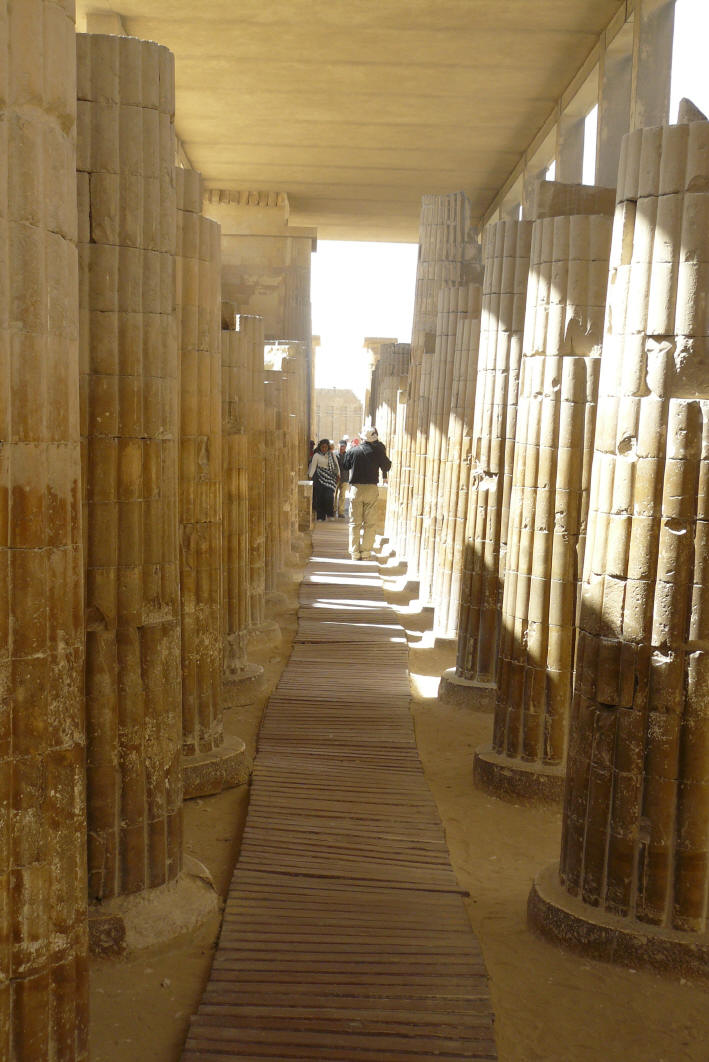
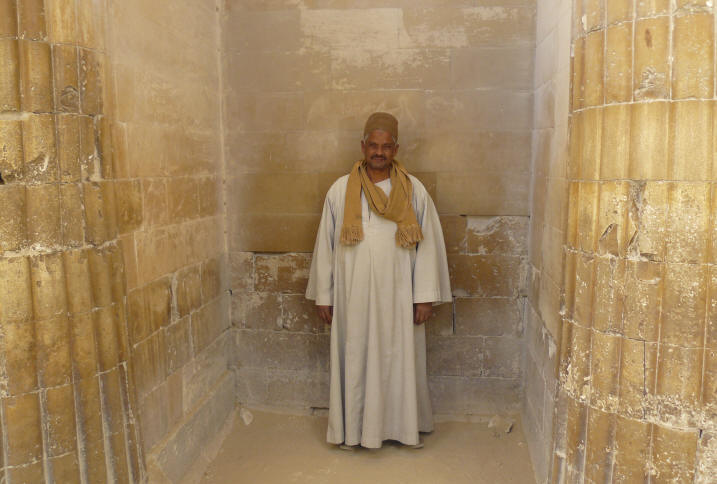
There could have been several cashiers of each
language group to handle the purchases of those who spoke the
various languages. Of course, the Egyptologists think all these
little cubicles were for statues, however, no pedestals were found
in the remains, which is a very important point, because these
statues were always erected on pedestals. Statues may vanish, but
pedestals remain.
The design of the eleven pits is impressive. There
are eleven of them, with only one containing a very elaborate
stairway all the way to the bottom. All the pits are connected to
each other by a subterranean tunnel -- the pits were filled and the
tops were sealed with wooden timbers and stone. And, all of the
grain could be accessed from one entrance -- and there is one
entrance into the pits from outside the wall enclosure of the
complex. Last of all, grain was found in the floor of these pits,
which has been explained by Egyptologists as having been from foods
buried with deceased who were buried there -- however, no evidence
of burials was ever found in these pits.
Does this fit the Biblical account? When Joseph's
brothers came to him for grain, they talked to Joseph and paid for
the grain. When they received the grain, it was already in sacks:
-
"Then Joseph commanded to fill their sacks with
corn, and to restore every man's money into his sack, and to give
them provision for the way: and thus did he unto them. And they
laded their asses with the corn, and departed thence. And as one
of them opened his sack to give his ass provender in the inn, he
espied his money; for, behold, it was in his sack's mouth."
Genesis 42:25-27
The complex at Sakkara is unique -- nothing like it
has ever been found. It was described by William Hayes as being a
"veritable city in itself, planned and executed as a single unit and
built of fine white limestone from the nearby Mukattam Hills." (The
Scepter of Egypt, Vol. 1, p. 60.)
In fact, Egyptologists tend to term everything they
find as a royal tomb, which is what they have called this complex.
But it in fact exhibits every feature indicative of being a center
of great activity, a feature which again fits with the story of
Joseph.
When Joseph's brothers came to get grain, they came
face to face with Joseph who was overseeing the distribution. Where
did they go to get the grain? They went to wherever the grain was
stored, and this was where Joseph was. And the storage of such a
massive amount of grain would have required a large storage area,
such as the extremely large pits found in this complex. It is also
reasonable to expect to find the storage pits within an enclosure
such as this complex, with an area for the payment of the grain.
This was a business and would have required a center of
administration.
A great deal has been written about this complex,
and most mention the uniqueness of it -- something they cannot
explain. In fact, when you ask the Egyptians what the huge pits were
for, they admit that they just don't know.
Some ancient historians have written of the fact
that the pyramids were once believed to be "Joseph's storage bins"
for the grain, and perhaps this story has its roots in the fact
Joseph designed the first pyramid in the same complex in which the
grain was stored. But regardless of what the experts want to believe
about the Step Pyramid complex, the circumstantial evidence fits the
story of Joseph perfectly. And, it is one of the best preserved
sites in Egypt -- certainly of the very old structures -- and this
is consistent with God's preservation of important evidences which
confirm the total accuracy of His Word.
The Search for Imhotep's Tomb
We know from the Bible that Joseph died in Egypt and
was embalmed and placed in a coffin.
-
"So Joseph died, being an hundred and ten years
old: and they embalmed him, and he was put in a coffin in Egypt.
But, when the children of Israel left during the Exodus, his bones
were taken with them:" Genesis 50:26
This leads us to think that Joseph would have had a
royal tomb in Egypt, but that it was possibly taken over and used by
someone else, we just don't really know. But one of the big
mysteries for Egyptologists has been the tomb of Imhotep -- they
simply can't find it although they know it should be somewhere in
Sakkara. So important is Imhotep to Egyptology, that in the
Guidebook to Sakkara by Jill Kamil, "The Tomb of Imhotep" is
listed as a subject heading, only to explain that it has not been
found.
In our discussion of "Imhotep, the Physician," we
mentioned that ancient Greek texts speak of a place near Memphis
where people came to worship Imhotep and be healed. When excavators
continued to search for Imhotep's tomb very near the Step Pyramid,
they found an incredible labyrinth of underground tunnels, full of
mummified ibis (birds) and bulls in separate galleries. Inscriptions
and coins found here show that people came here to be healed! They
had found this "sanctuary to Imhotep" written of by the Greeks.
After the deification of Imhotep as "god of
medicine," he was given the title, "Chief One of the Ibis" -- and
this was the connection of this labyrinth with Imhotep. These
hundreds of thousands of ibis were mummified and brought here as
tribute to Imhotep, filling these tunnels.
It was later discovered that these galleries
connected to a pit that extends down to a funerary chamber which
contains an empty coffin. They also discovered that this chamber
belonged to a very large mastaba tomb which contained a second
chamber full of broken stone vessels, and in the tomb's storerooms
were jars whose clay-stoppers had the seal impression of Djoser!
Here is absolute proof that this was the tomb of a
very important person of Djoser's reign. No inscriptions were found
on the walls and the sarcophagus was empty. But even more
importantly, this mastaba is oriented to the north instead of the
east, as the other pyramids and mastabas are. This was an important
tomb of someone from Djoser's time -- but the sarcophagus was empty.
There was even found an inscription by an anonymous
Greek who came here, telling how he was cured -- and it was through
a dream! Once again, the evidence speaks loudly of a wonderful story
from the Bible -- the story of Joseph.
(This newsletter courtesy
anchorstone.com) |

![]()